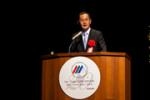2012/10/08
On October 8th, the Nobel Committee announced that it had awarded this year's Nobel Prize in Physiology or Medicine, given to those who have made significant discoveries in physiology or medicine, to NAIST Honorary Professor Shinya Yamanaka (Director, Center for iPS Cell Research and Application, Kyoto University).
Professor Yamanaka came to NAIST in December 1999 as an Associate Professor in the Research and Education Center for Genetic Information and in 2003 he became a full Professor. In October, 2004, he moved to Kyoto University's Institute for Frontier Medical Sciences, but also continued as a professor in NAIST's Research and Education Center for Genetic Information until March 2005. Then, from April 2005 to March 2007, he was a Visiting Professor in our Graduate School of Biological Sciences. While Professor Yamanaka was here at NAIST, his research produced important results which eventually led to the creation of the induced Pluripotent Stem (iPS) cell, the main research leading to his Nobel award.
We at NAIST are proud to learn of Professor Yamanaka's Nobel Prize and we would like to express our heartfelt congratulations for receiving such a distinctive honor. We also look forward to Professor Yamanaka's continued research and successes of in the future.
【NAIST President's Comments in Celebration of NAIST Honorary Professor Shinya Yamanaka receiving Nobel Prize in Physiology or Medicine】
Hearing of Professor Shinya Yamanaka's Nobel Prize in Physiology or Medicine, and as president of the institute where he began his research on induced Pluripotent Stem (iPS) cells, the research work that led to this award, I am overjoyed with this auspicious announcement. I would like to express my heartfelt congratulations to Professor Yamanaka and all who have worked with him on this research.
Professor Yamanaka had a clear vision of producing a cell that had the same potential capacity of Embryonic Stem (ES) cells, without using fertilized eggs. He brilliantly succeeded in the rejuvenation of human cells, making a significant contribution to the medical world. Professor Yamanaka has always said that the origin of his research can be found at NAIST, and that coming to NAIST allowed him to begin this research. Since its founding, NAIST's support of young researchers such as Professor Yamanaka, working on the cutting edge of science and technology, has been a significant part of our role as a research institute.
With this Nobel Prize, I believe Professor Yamanaka has truly become an esteemed figure of the Japanese scientific community. He is still young, and I believe that his research will only grow more promising with time. I pray that he will take care of himself so that he may continue his meaningful research.
President Akira Isogai
October 8, 2012
The Official Web Site of the Nobel Prize
http://www.nobelprize.org/
Professor Shinya Yamanaka, Director of the Center for iPS Cell Research and Application of Kyoto University (CiRA) and NAIST Honorary Professor, gave a commemorative lecture entitled "Advancements in iPS Cell Research" at the NAIST 20th Anniversary Ceremony on October 1, 2011. During his enthralling talk, Professor Yamanaka traced his current research back to the research he started here at NAIST. For more information:
http://www.naist.jp/en/university_news/news/20th_ceremony/02_2011Yamanaka_Abstract.pdf





